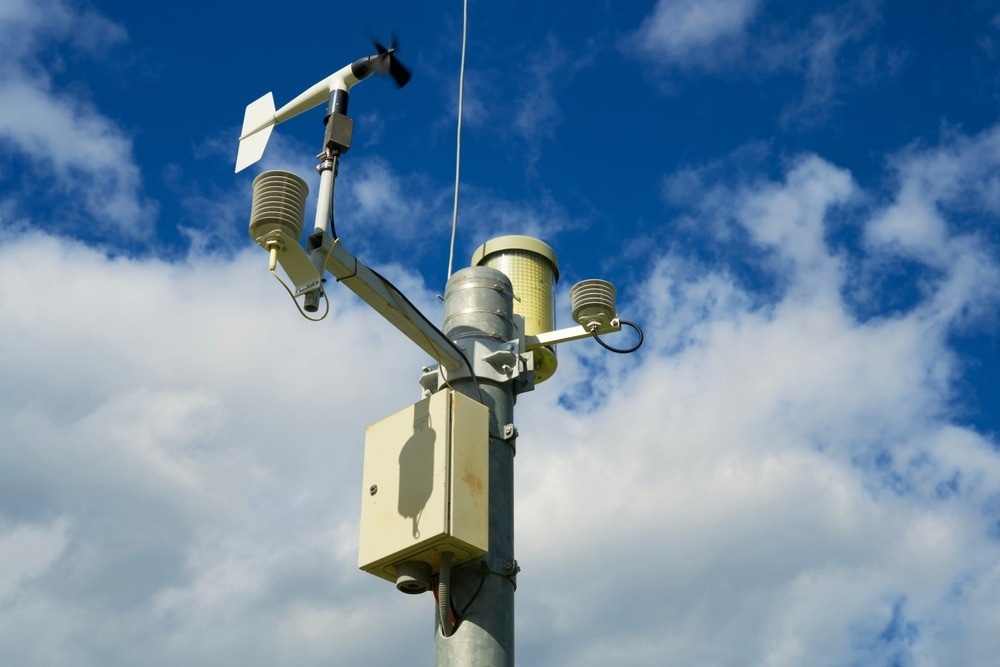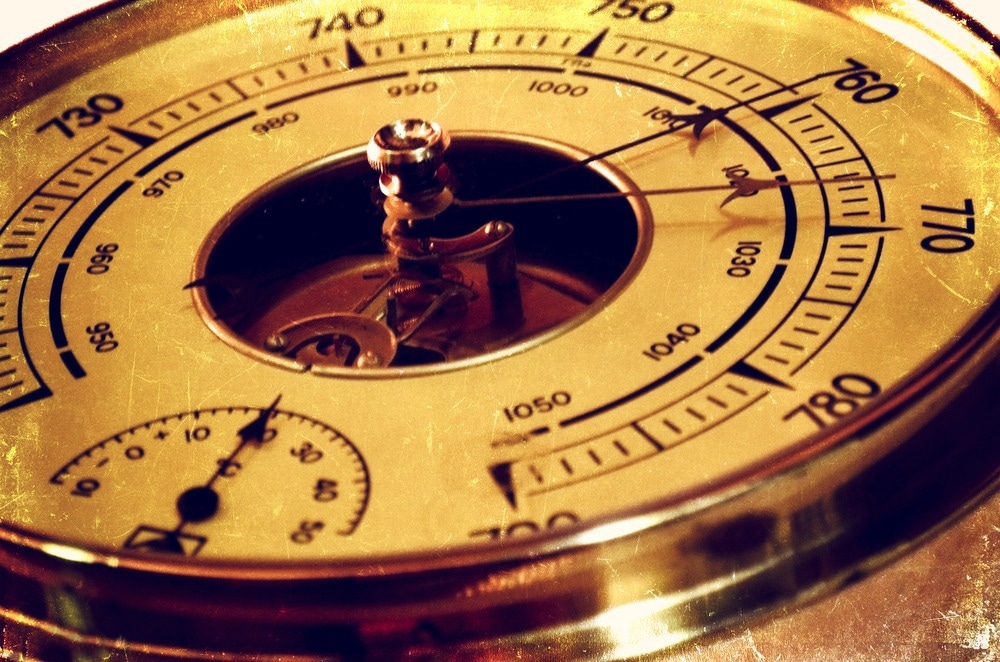A barometer is a scientific instrument that has been historically used to predict weather changes and, recently, it is being used for many other applications as well. Atmospheric pressure changes are also referred to as barometric pressure and can be measured using a barometer.

Image Credit: Rene Notenbomer/Shutterstock.com
The Earth’s atmosphere can be described as layers of air surrounding the planet. The air has a weight and a tendency to compress anything it touches. Simultaneously, the same object is also exposed to gravitational pull. Changes in the atmosphere can be detected through the changes in air pressure.
Invention and Principle of Barometer
The concept of atmospheric pressure was brought to light by the Italian scientist Giovanni Batista Baliani.1 This concept was later supported by the Italian astronomer and mathematician Gasparo Berti.
In 1644, Evangelista Torricelli conducted experiments using a tube/column filled with mercury, which is about 13.5 times as dense as water. It is believed that the apparatus used for this experiment was designed by Vincenzo Viviani, an Italian mathematician and scientist, who was also Torricelli’s friend.2
Torricelli observed that when the tube filled with mercury was inverted in a dish filled with mercury, the mercury did not flow out of the tube. Instead, there was a gap at the top end of the tube, which was filled with vacuum. A daily variation in the height of the mercury column was observed, which was incorrectly assumed to be caused by temperature variations.
Torricelli's experiment indicated that the weight of the air outside the column was responsible for pressing down the mercury in the dish. The extent of this pressure could be measured by the height of the mercury in the column.
Blaise Pascal conducted a similar experiment in Paris using a mercury barometer designed by Torricelli. In the late 18th century, a mercury barometer was equipped with a Vernier scale.3
Florin Perier first proposed that the atmospheric pressure drops with an increase in altitude.4 This observation was based on the experimental findings using Torricelli’s mercury barometer.
Atmospheric pressure drops at a higher altitude because the air density is lower at a higher altitude, which exerts less pressure. In contrast, when the altitude decreases, air density increases. Therefore, it is important to readjust or calibrate barometers when altitude change occurs; otherwise, there will be inaccurate atmospheric pressure readings.
Types of Barometers
The key types of barometers are discussed below:
Mercury Barometer:
This is the oldest type of barometer invented by Torricelli. Initially, a water barometer was designed which was more than ten meters in height. This massive apparatus evoked vile suspicion among Torricelli’s neighbors about the performance of witchcraft. As a result, a smaller mercury barometer was developed.
A mercury barometer is equipped with a glass tube that is closed at the top and open at the bottom. As explained earlier, the open end of the tube is placed on a circular shallow dish. The mercury height in the tube adjusts to match the atmospheric pressure above the dish. At sea level, the barometer reading is approximately 760 mm.
Aneroid Barometer:
Lucien Vidi, a French scientist, invented the aneroid barometer in 1844. This barometer comprises a sealed metal chamber that can expand and contract depending on the atmospheric pressure surrounding it. The measurement of this expansion and contraction is aligned with atmospheres or bars.2
The display of the aneroid barometer is similar to that of a circular clock, where the hand moves to indicate the current atmosphere. In due course, this barometer type replaced the mercury barometer because they were more economical, easier to operate, and could be moved from one place to another without the risk of mercury spillage.
Aneroid barometers that use a mechanical tool to detect atmospheric pressure changes are known as barographs.5
Digital Barometers:
Compared to other barometer types, digital barometers offer an accurate and quick measurement of complex atmospheric data. These provide barometric readings of current and previous hours in a bar chart format. The atmospheric data can be stored in a computer for further analysis in the future. At present, most meteorologists and scientists use digital barometers for laboratory or field experiments.
At present, micro-electromechanical systems (MEMS) barometers are manufactured by many companies, including Bosch, Measurement Specialities, and ST Microelectronics.

Image Credit: Ensuper/Shutterstock.com
Applications of Barometers
Weather Forecast:
For many years, humans have used barometric pressure readings to predict weather. A high barometric pressure indicates hot, dry weather, whereas a low pressure signifies damp weather. A high pressure indicates that the atmosphere contains dense or heavy air. This condition brings a very clear sky and allows the sun to cut through and warm Earth’s surface.
A rapid drop in barometric pressure indicates the development of low pressure. A region with a low atmospheric pressure promotes cloud formation, which could block the sun. This condition indicates a higher chance of snow or rain. Low pressure also forms heavy wind because this condition allows surface air to move freely.
Hurricanes may form at exceptionally low atmospheric pressure.6
Some smartphones are equipped with digital barometers to obtain atmospheric pressure data. This data is used by the device’s GPS receiver to pinpoint a location more accurately. Put simply, a smartphone with a digital barometer helps in navigation.
Software engineers have developed apps, such as PressureNet, that can automatically collect barometric readings from each of its users. Subsequently, a vast atmospheric data network is created that simplifies the process of mapping storm developments, particularly in areas with fewer weather stations.2
Other Uses:
Tracking of human activity through a barometer is a fairly recent phenomenon. The ubiquity of MEMs in smartphones and other wearable electronics has made them a natural candidate to study human activity (and movement) recognition.
Human activity tracking is achieved by detecting the changes in vertical movement. Smartphones equipped with barometers can predict changes in altitude with high accuracy; therefore, they help monitor physical exercise like running, playing, and walking.7
In climate-controlled buildings, the changes in atmospheric pressure are exploited to detect indoor-to-outdoor transitions. Barometric sensors are also used to assess traffic congestion.8
References and Further Reading
Baliani, G. Complete Dictionary of Scientific Biography. Available at: https://www.encyclopedia.com/science/dictionaries-thesauruses-pictures-and-press-releases/baliani-giovanni-battista
Barometer. National Geographic. https://education.nationalgeographic.org/resource/barometer/
Barometer. Encyclopedia Britannica. 2023; Available at: https://www.britannica.com/technology/barometer
The History of Atmospheric Discovery. UCAR Center for Science Education. Available at: https://scied.ucar.edu/learning-zone/atmosphere/history-discovery-atmosphere
Gieseler, E. (1889) The aneroid barometer, its various forms, its theory and its use, with special reference to the determination of altitudes. J. Frank. Instit. 128(5), 321-338. doi.org/10.1016/0016-0032(89)90127-0
Torricelli Demonstrates the Existence of a Vacuum. APS News. https://www.aps.org/publications/apsnews/201210/physicshistory.cfm (Assessed on December 10, 2023)
Manivannan, A., et al. (2023). On the Challenges and Potential of Using Barometric Sensors to Track Human Activity. Sensors (Basel, Switzerland), 20(23). doi.org/10.3390/s20236786
Dimri, A., et al. (2026). RoadSphygmo: Using barometer for traffic congestion detection; Proceedings of the 2016 8th International Conference on Communication Systems and Networks (COMSNETS). pp. 1–8.
Disclaimer: The views expressed here are those of the author expressed in their private capacity and do not necessarily represent the views of AZoM.com Limited T/A AZoNetwork the owner and operator of this website. This disclaimer forms part of the Terms and conditions of use of this website.